How to propagate a spider plant
Taking care of Spider plants is rewarding, because when done well, you grow baby spider plants. You can choose to propagate these. Find out how to propagate spider plants and grow more of them in a short period of time.
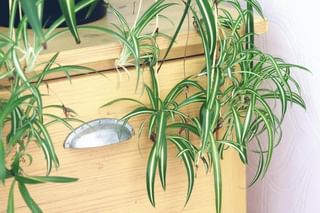
Propagation is very simple with the spider plant. If your plant gets to a certain size, it'll start to grow small offshoots which you can propagate!
The plant rewards your good care with new plants, how amazing is that? In this plant care guide, we'll go over everything you need to know about propagating your spider plant and what steps you can take to go through the whole process.
In this guide, we'll cover these topics:
Before you read this post, make sure you've read How to care for a spider plant. Because, without good care, you won't be able to propagate this wonderful houseplant. Now that you know how to take care of your spider plant, let's get started and find out how you can turn your baby spider plants into fully-grown plants.
When do I propagate a spider plant?
You've given your spider plant great care for a while and little shoots like this start to pop out of the parent plant:
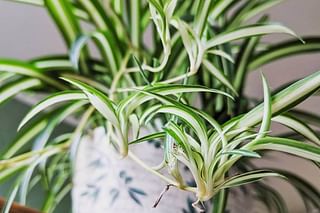
As soon as these little shoots are starting to grow their roots, you know they're ready for propagation. You can choose to leave these baby plants on the parent plant, but you can also choose to propagate them and let them grow up to be big plants themselves.
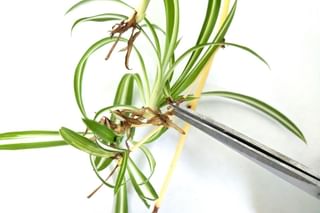
This is a picture of one of the spouts up close. You can see that it already has small roots.
When the roots are as large or larger than this, you can cut them off the parent plant with some scissors, as shown in the picture. If you cut them off the mother plant any earlier, you can risk losing them, as those roots won't be able to absorb enough nutrients to keep the plant alive.
So be sure to wait a little longer if you're unsure whether the roots are long enough for the plant to be self-sufficient.
It's also important to wait for the right time of year to propagate your Spider plants. Most plants, including the Spider plant, stop growing in the fall and winter and shouldn't be propagated during this time of year.
For the best result, only propagate your houseplants in the spring and summer.
What materials do I need to propagate a spider plant?
Propagating a Spider plant is very easy and you'll only need a few tools to get started. Here's what you'll need:
- Sharp scissors or pruning shears
- Potting soil
- Plant containers and/or pots
- Watering can (optional)
Once you have all the necessary materials, you're ready to propagate these amazing sprouts.
How do I propagate a spider plant?
When you cut off the spouts from the parent plant, after they've grown roots to a sustainable size, you can plant them in some soil. If you want to be able to see the roots of the plant grow, you can also put them into a small jar with water.
If you're growing your spider plant cuttings in water, you can move them to soil when the roots are about 5 cm (2 inches). This way you can watch the root grow and you can plant them in soil later on.
We've laid out some spider plant sprouts in the picture below to give you a good view of what your sprouts should resemble during propagation. You can see that the sizes of the sprouts vary a little bit. This is okay, the most important things are the size of the roots.
If the roots are healthy and strong, there is a high chance that you'll have a healthy and strong plant. The size of the sprout itself doesn't matter, but the size of the roots does.
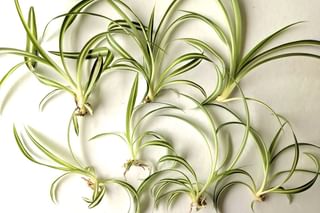
The sprouts in the picture above will all be planted in soil, but you can also propagate them in water. This is up to you and what you prefer.
This just goes to show that you can propagate these plants in different ways. The smaller sprouts are placed together in a pot because they still have plenty of space to grow. If the initial sprouts are of a good size, like the top 3 in the picture, they can grow in a small pot by themselves. These sprouts will need a bit of extra space in the short term. The smaller sprouts, like the 4 at the bottom, will grow in the same pot. Each of the containers will contain two of the smaller sprouts. Again, this is up to what you have and what you prefer. Spider plants do like to be root bound, so don't give them a really large pot right away.
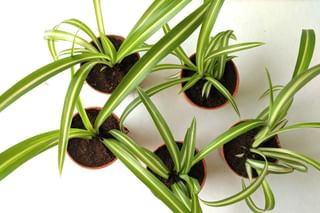
This is the result of planting the sprouts. They're all planted in small pots. This stimulates growth, as these plants love to be in small, confined spaces. They love to take over the pot and grow their roots all over the place.
In the picture below you can see spouts in different stages of development and how quickly they grow. These spider plants are propagated just a few weeks apart. Some are still small and others have developed themselves into fully-fledged spider plants.
How long does it take for the propagated spider plant to root?
Once you've placed your cuttings in the soil, the cuttings will start to grow. Your cuttings will already have roots, but will need to settle into their new situation: Being an independent plant. On average, these plants take 1-2 weeks before they've settled in a start to grow their roots and leaves again.
What happens after propagating a spider plant?
The more the roots grow, the more of the pot they will take over. At a certain point, you will need to repot them. You can read all about this in my guide Everything about repotting a spider plant.
At this point, you can also choose to place several of these grown sprouts together in a container. This will again stimulate growth because they'll be in a tight space again, but they will have more room to grow. This is exactly what I did with the spider plants in the picture below. The pots on the left contain the plants that were all the small sprouts that were planted in the smaller pots. The bigger pots on the right are 2 or 3 of the smaller containers combined after the sprouts had outgrown the small containers.
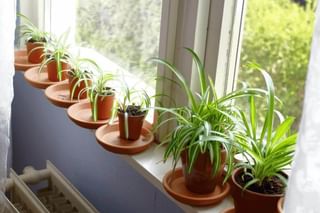
Hopefully, this post helps you to grow more spider plants for your house and/or to give away to friends and family. When you care well for these small, new plants, they'll grow out to be big and strong.
Thank you for reading this post! I hope it helps you to keep your plants healthy and beautiful! If you're looking for more guides on specific plants, you can always request a plant guide to get a guide for the plant you have trouble with.
Test your plant care knowledge
Quiz completed!
Want to learn more? Sign up for my newsletter to receive free tips in your inbox!
Sign up now!




